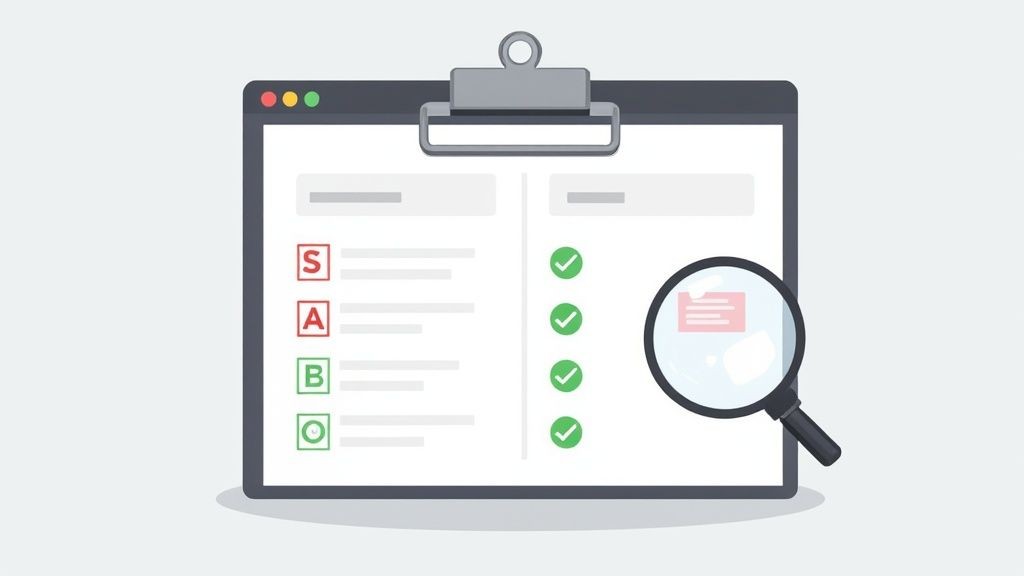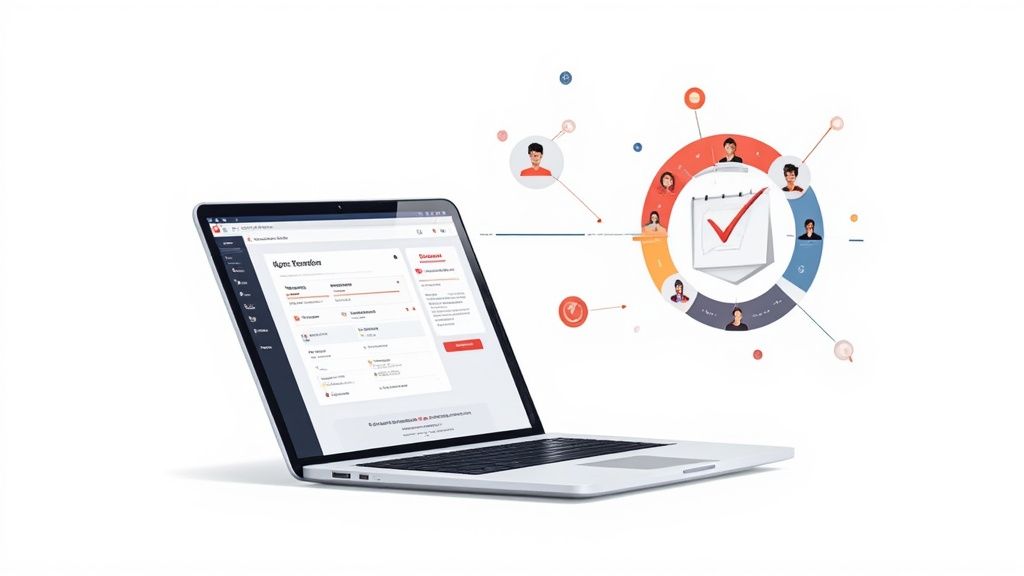In today's data-driven landscape, the quality of your insights is directly tied to the quality of your data. Collecting information is easy; collecting the right information, ethically and efficiently, is where the real challenge lies. For event marketers and businesses alike, mastering data collection isn't just a technical task. It's a strategic imperative that builds trust, informs decisions, and drives growth.
Poor data practices lead to flawed strategies, wasted resources, and missed opportunities. This guide moves beyond generic advice, offering a comprehensive roundup of the 10 most critical, actionable best practices for data collection. We will cover everything from setting clear objectives and ensuring privacy compliance to implementing automation and maintaining rigorous quality controls.
Whether you're refining your event registration process or building a large-scale data pipeline, these principles will help you create a robust framework for gathering valuable, reliable, and compliant data. By the end of this article, you will have a clear, step-by-step blueprint to transform your data collection efforts from a simple task into a powerful strategic advantage. Let's dive into the practices that separate noisy, unreliable data from clean, actionable insights.
1. Define Clear Data Collection Objectives
Before capturing a single piece of data at your event, it's essential to establish a clear purpose. This foundational step involves setting specific, measurable, achievable, relevant, and time-bound (SMART) goals that anchor your entire data strategy. Without them, you risk gathering vast amounts of irrelevant "data noise," wasting resources and obscuring valuable insights.
Defining your objectives transforms data collection from a passive task into a strategic asset. By identifying exactly what you need to know and why, you ensure every data point serves a distinct purpose. This clarity is a cornerstone of the best practices for data collection, guiding your efforts toward tangible business outcomes, whether that's improving attendee engagement, measuring sponsor ROI, or optimizing future event programming.

Why This Is Crucial for Event Marketing
In the fast-paced world of event marketing, data drives decisions. Clear objectives ensure the information you collect directly informs critical actions. For instance, if your goal is to increase session attendance by 20%, your data collection will focus on tracking session check-ins, attendee feedback on topics, and pre-event registration patterns for specific talks. This targeted approach prevents resource drain and focuses your team on metrics that matter.
How to Implement This Practice
- Host a Stakeholder Workshop: Bring together key team members from marketing, sales, and event operations. Collaboratively define what a successful event looks like and what data is needed to measure that success.
- Document Your Objectives: Create a shared document that outlines each data collection goal. For example: "Collect job titles and company sizes from 90% of registrants to qualify leads for the post-event sales funnel."
- Link to Business Strategy: Ensure every objective aligns with broader company goals. If the business wants to expand into a new industry, a relevant data objective would be to identify the industry breakdown of your event attendees.
2. Implement Data Validation and Quality Checks
Collecting data is only half the battle; ensuring its accuracy, completeness, and consistency is what creates real value. Implementing data validation and quality checks involves establishing systematic processes to verify information at the point of entry and throughout its lifecycle. This prevents "garbage in, garbage out" scenarios, where flawed data leads to poor decisions and wasted marketing efforts.
These checks can range from simple real-time validation rules in registration forms to complex automated quality assurance mechanisms that clean and standardize data post-collection. This proactive approach to data integrity is a fundamental component of the best practices for data collection. It ensures the insights you derive are built on a foundation of trustworthy, high-quality information, making your event analytics reliable and actionable.

Why This Is Crucial for Event Marketing
In event marketing, poor data quality can have immediate consequences. An invalid email address means a lost lead, an incorrect job title misinforms your sales team, and inconsistent company names skew your account-based marketing (ABM) analytics. Data validation ensures every piece of information you collect is usable, maximizing the ROI of your lead generation and personalization strategies. Clean data is the fuel for effective post-event follow-ups and attendee segmentation.
How to Implement This Practice
- Enforce Field-Level Validation: Use your registration forms to set rules for critical fields. For example, ensure email addresses contain an "@" symbol and a valid domain, or restrict phone number fields to numeric characters only. For more guidance, explore these best practices for form design.
- Automate Post-Collection Cleaning: Employ tools that can automatically detect duplicates, standardize fields like "Job Title" or "Country," and flag incomplete records for manual review. This saves significant time and reduces human error.
- Establish Data Quality KPIs: Define and monitor key metrics for your data, such as completion rate, accuracy percentage, and the number of duplicate records. Regularly review these KPIs to identify and address systemic issues in your collection process.
3. Ensure Informed Consent and Privacy Compliance
Beyond simply collecting data, organizations have an ethical and legal responsibility to protect it. This involves obtaining explicit, informed consent from individuals before capturing their information and adhering strictly to privacy regulations like GDPR and CCPA. This practice isn't just about avoiding fines; it's about building trust and demonstrating respect for your audience's personal information.
Adhering to these standards is a fundamental component of the best practices for data collection. It ensures your methods are transparent, ethical, and legally sound, which strengthens your brand's reputation. When attendees understand what data you are collecting and why, they are more likely to provide it willingly and accurately, leading to higher-quality insights for your event strategy.

Why This Is Crucial for Event Marketing
In event marketing, personal data is the currency that fuels personalization and lead generation. However, mishandling this data can lead to severe legal penalties and irreparable damage to your reputation. For example, failing to get clear consent for post-event marketing emails can result in high unsubscribe rates and spam complaints, harming your sender reputation and violating regulations. By prioritizing consent, you ensure your marketing efforts are welcomed, not intrusive.
How to Implement This Practice
- Use Clear and Simple Language: Avoid legal jargon in your consent forms. Clearly state what data you are collecting, how it will be used, and who it will be shared with. For a deep dive, you can learn more about GDPR compliance for websites.
- Offer Granular Choices: Instead of a single "I agree" checkbox, allow attendees to opt into different types of communication separately, such as session updates, sponsor emails, and future event newsletters.
- Implement Privacy by Design: Build privacy considerations into your event technology from the ground up. Ensure systems that store or process personal data have robust security measures and access controls in place.
- Maintain Consent Records: Keep a secure, auditable trail of when and how each attendee gave their consent. This is a key requirement for many privacy laws and is crucial for demonstrating compliance.
4. Use Standardized Data Collection Methods and Formats
Once your objectives are set, enforcing consistency across your data is the next critical step. This involves adopting standardized collection protocols, templates, and formats (like CSV or JSON) across every touchpoint, from registration forms to post-event surveys. Standardization ensures that a "job title" collected in one system is identical in structure and meaning to one collected elsewhere, preventing data chaos.
This disciplined approach transforms disparate data points into a cohesive, interoperable dataset. Adopting uniform standards is one of the most impactful best practices for data collection because it eliminates ambiguity, drastically reduces data cleaning time, and simplifies integration between different software platforms. This consistency ensures your data is not just collected, but is analysis-ready from the start.
Why This Is Crucial for Event Marketing
In event marketing, data flows from multiple sources: ticketing platforms, mobile apps, CRM systems, and lead capture tools. Without standardization, you might have dates formatted as "MM/DD/YY," "DD-MM-YYYY," and "Month Day, Year" all in one dataset, making analysis impossible. Standardizing formats, like using the ISO 8601 standard for dates, ensures every piece of information can be seamlessly merged, compared, and analyzed to reveal a complete picture of your event's performance.
How to Implement This Practice
- Create a Data Dictionary: Develop a central document that defines every data field you collect. Specify its name, format (e.g., text, number, date), and accepted values (e.g., a dropdown list for "Industry").
- Use Field Validation: Implement rules in your forms and data capture tools to enforce correct formatting. For instance, require phone numbers to follow a specific pattern or ensure email fields contain an "@" symbol.
- Adopt Industry Standards: Where possible, use established standards. For example, use two-letter country codes (ISO 3166) instead of allowing free-text country names, which prevents variations like "USA," "U.S.," and "United States."
5. Establish Data Source Credibility and Verification
Not all data is created equal. Before integrating any information into your systems, it's vital to evaluate its reliability, accuracy, and origin. This practice involves authenticating where your data comes from, implementing verification mechanisms, and consistently monitoring the quality of each source. Without this step, you risk making critical decisions based on flawed or incomplete information.
Establishing source credibility is fundamental to building a trustworthy data foundation. It transforms your data collection from a simple accumulation of facts into a curated repository of high-quality intelligence. This verification process is one of the most critical best practices for data collection, ensuring that insights derived from your event data are accurate, defensible, and ultimately more valuable for driving strategic marketing decisions.
Why This Is Crucial for Event Marketing
In event marketing, data can flow from dozens of sources: registration platforms, social media engagement, third-party lead lists, and on-site scanners. If a primary registration platform has a data entry glitch or a lead list is outdated, subsequent marketing campaigns will be ineffective. Verifying that each source provides clean, accurate data prevents wasted ad spend, protects your brand’s reputation, and ensures your sales team receives genuinely qualified leads.
How to Implement This Practice
- Create a Source Registry: Document every data source you use, including its origin, the type of data it provides, and a quality rating. For example, note that lead data from a partner webinar is more reliable than a purchased list.
- Implement Data Lineage Tracking: Use tools or processes to map the flow of data from its source to its destination. This helps you quickly identify the origin of any data quality issues that arise.
- Cross-Reference and Validate: Compare data from different sources to check for inconsistencies. For instance, you can cross-reference attendee company information from your registration form with data from a professional networking platform to validate its accuracy.
6. Minimize Bias and Ensure Representative Sampling
Collecting data is not enough; the data must accurately reflect your target audience. Minimizing bias and ensuring a representative sample are essential for drawing valid conclusions. This involves using methodological techniques to reduce systematic errors that can skew your results, ensuring that the insights you gather are a true representation of the entire group you're studying, not just a vocal or easily accessible segment.
Failing to address bias can lead to flawed strategies built on misleading information. This practice is a cornerstone of reliable data analysis and one of the most critical best practices for data collection. It ensures your decisions are based on an accurate understanding of your audience, whether you're gauging attendee satisfaction or measuring market interest in a new product.

Why This Is Crucial for Event Marketing
In event marketing, selection bias can easily creep in. For instance, if you only survey attendees who visit a specific booth, your feedback will be skewed and won't represent those who didn't. By employing techniques like stratified or random sampling for post-event surveys, you ensure that feedback from different attendee segments (like VIPs, general admission, and students) is proportionally represented, leading to more accurate insights for future event planning.
How to Implement This Practice
- Use Random Sampling: When sending out feedback surveys, randomly select a portion of your attendee list rather than only sending it to the most engaged participants. This gives everyone an equal chance of being heard.
- Segment and Stratify: Before collecting data, break your audience into relevant subgroups (e.g., by ticket type, industry, or first-time vs. repeat attendees). Ensure you collect data from each group in proportion to its size in your overall audience.
- Track Non-Response Rates: Monitor who isn't responding to your data requests. If a specific group is consistently underrepresented, they may have different opinions than your respondents. Consider offering incentives or using different channels to reach them.
7. Implement Automated Data Collection Where Feasible
Leveraging technology to automate data collection is essential for scaling your efforts and ensuring high-quality information. This practice involves using systems like APIs, sensors, or automated logging to capture data without manual intervention. Automation minimizes human error, increases efficiency, and provides a consistent stream of real-time data that would be impossible to gather by hand.
By automating repetitive tasks, you free up your team to focus on analysis and strategy rather than tedious data entry. This shift makes automation a critical component of the best practices for data collection, transforming your ability to gather accurate insights at scale. From tracking website engagement with Google Analytics to using RFID scanners for session check-ins, automation ensures your data is both reliable and timely, empowering quicker, more informed decisions.
Why This Is Crucial for Event Marketing
In event marketing, speed and accuracy are paramount. Automated systems can instantly capture attendee registrations, session attendance, and digital engagement, providing a live look at event performance. For instance, an integrated registration platform can automatically populate your CRM with new leads, tag them appropriately, and trigger welcome emails. This eliminates delays and reduces the risk of data being lost or entered incorrectly, ensuring a seamless experience for both your team and your attendees.
How to Implement This Practice
- Identify High-Volume, Repetitive Tasks: Start by pinpointing which data collection processes are the most time-consuming and prone to error, such as transcribing feedback forms or manually logging social media mentions. These are prime candidates for automation.
- Use Webhooks and APIs for Real-Time Updates: Integrate your event platforms with other business systems using APIs. Tools like webhooks can push data from one application to another automatically as events happen. To explore this further, you can learn more about how webhooks enable real-time data transfer.
- Monitor and Maintain Automation Systems: Regularly check your automated workflows to ensure they are functioning correctly. Set up alerts for system failures and maintain a manual backup process for mission-critical data collection points.
8. Maintain Comprehensive Data Documentation and Metadata
Collecting data is only half the battle; ensuring it remains understandable, trustworthy, and usable over time is equally important. This is where comprehensive documentation and metadata come into play. This practice involves creating a detailed record of what your data is, where it came from (lineage), how it was collected, and what each variable means. Without this context, your dataset can quickly become a "black box," losing value as institutional knowledge fades.
Thorough documentation transforms raw data into a long-term, shareable asset. By maintaining a data dictionary and clear metadata, you empower both current and future team members to interpret and leverage the information correctly. This commitment to clarity is one of the most critical best practices for data collection, preventing misinterpretation and ensuring the longevity and integrity of your event insights.
Why This Is Crucial for Event Marketing
In event marketing, team members and project goals can change quickly. If a new marketer joins your team to analyze last year's event performance, they need to understand what "Engagement_Score_Q3" actually means. Was it based on poll participation, session attendance, or booth visits? Clear documentation provides this context, ensuring consistent analysis and reliable year-over-year comparisons. It makes your data an enduring resource rather than a one-time report.
How to Implement This Practice
- Create a Data Dictionary: Develop a central document or spreadsheet that lists every data field you collect. For each field, define its name (e.g.,
session_check_in), provide a clear description ("Timestamp of attendee scanning into a specific session"), and note the data type (e.g., Datetime). - Document Collection Methods: For each data point, record how it was gathered. For example: "Attendee job titles were collected via a mandatory dropdown field in the online registration form, which was updated on May 15, 2023."
- Establish Version Control: Store your documentation in a shared location where changes are tracked, such as a company wiki or a version control system like Git. This ensures everyone is working from the most current information and can see a history of changes.
9. Establish Data Access Controls and Security Measures
Collecting valuable data comes with a significant responsibility: it must be protected. Establishing robust data access controls and security measures is not just a technical necessity but a foundational element of trust. This involves implementing protocols like encryption and role-based access to safeguard sensitive information from unauthorized access, breaches, and misuse, ensuring data integrity and confidentiality.
This step transforms your data management from a potential liability into a secure, well-governed asset. By creating a secure environment, you not only comply with regulations like GDPR and CCPA but also build attendee confidence, which is crucial for long-term engagement. Protecting data is a critical component of the best practices for data collection, demonstrating your commitment to ethical and secure data handling and preserving your brand's reputation.
Why This Is Crucial for Event Marketing
In event marketing, you handle a wide range of personal information, from email addresses to professional details. A data breach can lead to severe financial penalties, legal action, and irreparable damage to your brand's credibility. Strong security measures ensure that the data you collect for personalization and lead nurturing doesn't become a vulnerability. It proves to attendees and sponsors that you are a trustworthy partner, encouraging them to share information more freely.
How to Implement This Practice
- Implement the Principle of Least Privilege: Grant team members access only to the data they absolutely need to perform their roles. A registration coordinator doesn't need access to sensitive sponsorship financial data.
- Use Encryption Everywhere: Encrypt data both in transit (while it's being sent over the internet) and at rest (while it's stored on your servers or cloud). This makes the data unreadable to unauthorized parties even if they gain access.
- Conduct Regular Security Training: Educate your team on security best practices, such as identifying phishing attempts, using strong passwords, and understanding their responsibilities in protecting attendee data.
10. Conduct Regular Data Quality Audits and Continuous Improvement
Data collection is not a one-time task; it's a dynamic process that requires ongoing attention to maintain its value. Conducting regular audits and fostering a culture of continuous improvement ensures that the data you collect remains accurate, relevant, and reliable over time. Without this vigilance, data quality can degrade, leading to flawed analysis and poor decision-making.
This practice transforms data management from a static function into an evolving, iterative cycle of measurement, analysis, and refinement. By systematically reviewing your data collection methods and their outputs, you can identify and correct issues before they compromise your strategic goals. This commitment to quality is one of the most critical best practices for data collection, as it protects the integrity of your entire data ecosystem and maximizes the return on your data-driven investments.
Why This Is Crucial for Event Marketing
In event marketing, data quality directly impacts everything from lead scoring to post-event communication. An audit might reveal that a high percentage of "job title" fields are being filled with generic terms, diminishing the value of your lead segmentation. Regular audits allow you to catch such issues, refine your registration forms or training for on-site staff, and ensure the data powering your campaigns is consistently high-quality.
How to Implement This Practice
- Define Data Quality Metrics: Establish clear, measurable standards for your data. Metrics could include completeness (e.g., 95% of records must have a valid email), accuracy (e.g., cross-referencing company names), and timeliness (e.g., leads must be synced to CRM within 12 hours).
- Establish a Review Cadence: Schedule regular data quality meetings, whether quarterly or bi-annually, with key stakeholders. Use these sessions to review performance against your metrics, discuss identified issues, and assign corrective actions.
- Automate Monitoring: Implement automated dashboards or alerts to monitor data quality in real-time. These tools can flag anomalies, such as a sudden drop in data completeness from a specific registration source, allowing for immediate intervention.
Top 10 Data Collection Best Practices Comparison
| Practice | 🔄 Implementation complexity | ⚡ Resource requirements | 📊⭐ Expected outcomes | Ideal use cases | 💡 Key tips |
|---|---|---|---|---|---|
| Define Clear Data Collection Objectives | Low–Medium — stakeholder alignment and planning | Low — time for workshops and documentation | More relevant data, reduced waste, higher ROI | New projects, redesigns, research planning | Involve stakeholders, document objectives, review quarterly |
| Implement Data Validation and Quality Checks | High — build rules, pipelines, and maintenance | Medium–High — engineering, tools, monitoring | Fewer errors, lower cleaning costs, more reliable analytics | Real-time systems, regulated domains, high-volume intake | Define KPIs, use automated tools, maintain validation rules |
| Ensure Informed Consent and Privacy Compliance | Medium — legal review and consent flows | Medium — legal, UX, compliance systems | Legal compliance, increased trust, lower regulatory risk | Healthcare, customer data, research with human subjects | Use simple language, granular consent, keep audit trails |
| Use Standardized Methods & Formats | Medium — standardization and governance | Medium — schemas, training, versioning | Easier integration, faster analysis, fewer transformation errors | Multi-system integrations, data sharing, long-term archives | Adopt industry standards, create a data dictionary, govern updates |
| Establish Data Source Credibility & Verification | Medium–High — source evaluation and lineage tracking | Medium — audits, third‑party checks, documentation | Higher data credibility and accountability | Aggregating external data, journalism, finance, research | Maintain a source registry, track lineage, revalidate periodically |
| Minimize Bias & Ensure Representative Sampling | High — design sampling and bias mitigation methods | Medium–High — statistical expertise, sampling costs | More generalizable, valid insights and decisions | Surveys, clinical trials, polling, A/B testing | Use randomization, power analysis, monitor non-response and weight as needed |
| Implement Automated Data Collection Where Feasible | High (initial) — integrations, pipelines, error handling | High — engineering, infrastructure, monitoring | Faster, scalable, more timely data with fewer manual errors | High-volume telemetry, web analytics, IoT, transaction systems | Start with repetitive tasks, implement retries, keep manual backup options |
| Maintain Comprehensive Documentation & Metadata | Medium — templates, versioning, ongoing updates | Medium — documentation tools, ownership, upkeep | Better discoverability, reuse, onboarding, and compliance | Large teams, long-lived datasets, regulated environments | Use templates, automate dictionaries, store docs in version control |
| Establish Data Access Controls & Security Measures | Medium–High — access policies, encryption, monitoring | High — security tools, audits, training | Protected sensitive data, regulatory compliance, reduced breach risk | PII/PHI, financial systems, research with sensitive data | Apply least privilege, encrypt at rest/in transit, audit access regularly |
| Conduct Regular Data Quality Audits & Continuous Improvement | Medium–High — audit cycles and remediation processes | Medium — QA teams, dashboards, tooling | Proactive issue detection, continuous quality gains, lower downstream costs | Mature data programs, regulated sectors, critical analytics pipelines | Define quality metrics, automate monitoring, hold regular review meetings |
Putting It All Together: Building a Foundation for Data Excellence
Mastering the best practices for data collection is not a one-time project; it's an ongoing commitment to excellence. The ten principles we've explored, from defining clear objectives to conducting regular audits, are not just isolated tasks. They are interconnected pillars that form the foundation of a reliable, ethical, and powerful data strategy. Viewing them as a holistic framework is the key to unlocking their true potential.
By moving beyond simply gathering information and instead focusing on building a high-integrity data ecosystem, you transform raw data into a strategic organizational asset. This approach ensures that every piece of information you collect is accurate, secure, and ready to deliver the insights you need to drive meaningful business outcomes. For event marketers, this means converting attendee information into a clear picture of audience behavior, preferences, and engagement drivers.
From Principles to Practice: Your Actionable Roadmap
The journey from understanding these concepts to implementing them can seem daunting, but it starts with small, deliberate steps. You don't need to overhaul your entire system overnight. Instead, focus on incremental improvements that build momentum.
- Start with a Self-Audit: Review your current data collection processes against the ten practices outlined in this article. Where are your biggest gaps? Are you collecting data without a clear purpose, or are your security protocols outdated? Identifying these weak points is the first step toward strengthening them.
- Prioritize Privacy and Consent: In today's landscape, trust is your most valuable currency. Make ensuring privacy compliance and obtaining informed consent your top priority. This not only mitigates legal risks but also builds stronger, more transparent relationships with your audience.
- Leverage the Right Technology: Adopting the right tools is crucial for implementing these best practices for data collection efficiently. For example, when organizing an event, your registration or RSVP form is your first point of contact. Using a platform designed with data integrity in mind, like our service, can automate validation, ensure secure data handling, and provide a standardized format right from the start.
Ultimately, investing in a robust data collection framework is an investment in your organization's future. It empowers you to make smarter, evidence-based decisions, personalize experiences, and cultivate lasting trust with your customers and attendees. Each step you take to improve your data quality is a step toward building a more intelligent, responsive, and successful enterprise. This commitment doesn't just prevent errors; it creates opportunities.
Ready to apply these best practices to your event data collection? Add to Calendar PRO offers secure, customizable RSVP and registration forms that help you gather clean, compliant, and actionable attendee data from the very first touchpoint. Streamline your process and start building a foundation of data excellence by exploring Add to Calendar PRO today.



